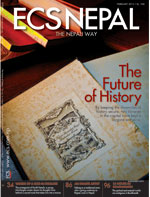Magic Carpet
Books or magic carpets are alive and well here and globally despite the predictions that the world would be paperless. Book shops are on the rise in Nepal and more and more Nepali authors are writing and publishing. Today, there are electronic books to read and also books that one can listen to. There is TV and radio that also computers with books that compete for your time. And there is, of course, the social media that makes people feel quite informed on a real time basis. All compete with books in one way or the other. In whatever way the math works, there are more bookstores, publishers and readers than ever before in Nepal. It is in this context that you will really enjoy our cover feature this month. ECS is looking at the two “really old libraries” in Nepal and bringing you their story. Each is an institution that has served scholars, researchers, students and authors well over time. Do take time out to visit them and have a public “library experience”.
Each month the ECS team is pleasantly surprised about all the events, people, places that we have not covered yet and the fact that there is a whole new way/angle to look at them. This month was no exception. We come across creative individuals who are turning waste into art. We see that the singing bowl and the aesthetic or therapeutic value that they bring are growing in popularity. I had a few colleagues who placed large orders for them from North America as office gifts last Christmas. I guess it helps reduce the stress that you caused them in the first place.
 Chitwan and Jomsom are locations that are familiar to everyone. What may not be familiar is what to do when one gets there. The options are growing each year. One symbolizes all the things that Rudyard Kipling describes in the famous Jungle Book; and the other, the part of Nepal that lies in the rain shadow of the Great Himalayan range. In the same way Bouddha and Changu Narayan are also two very familiar places for all residents and visitors to the Kathmandu valley. Both are undergoing change all the time, thankfully mostly for the better. These two ancient monuments are also inscribed in the UNESCO world heritage list and must be cared for as such.
Chitwan and Jomsom are locations that are familiar to everyone. What may not be familiar is what to do when one gets there. The options are growing each year. One symbolizes all the things that Rudyard Kipling describes in the famous Jungle Book; and the other, the part of Nepal that lies in the rain shadow of the Great Himalayan range. In the same way Bouddha and Changu Narayan are also two very familiar places for all residents and visitors to the Kathmandu valley. Both are undergoing change all the time, thankfully mostly for the better. These two ancient monuments are also inscribed in the UNESCO world heritage list and must be cared for as such.
Then there are all the cultural aspects of Nepal. The Kartik Nach of Patan is an excellent example of Nepal’s rich cultural heritage. The dance and performance is the result of many people with amazing skills coming together to create a fantastic final production. It is a process and product many sectors of this country could actually learn from.
We also have the regular features such as the performing arts, the various eating places and the wonderful food and drinks that are being served. We also feature organizations that are doing meaningful work in Nepal and the people who are behind these wonderful initiations. We hope you enjoy this issue of ECS and whatever you are doing in the coming month, make some time for the Nepali way.






